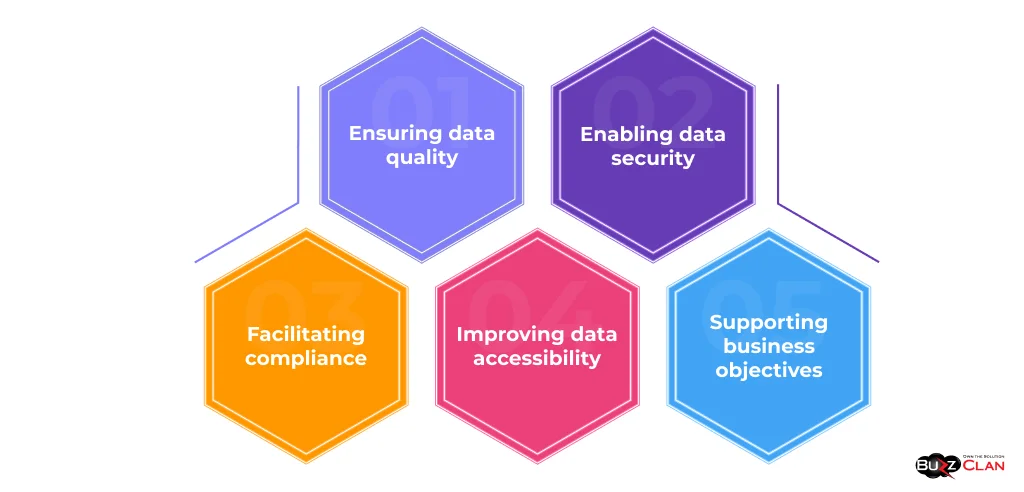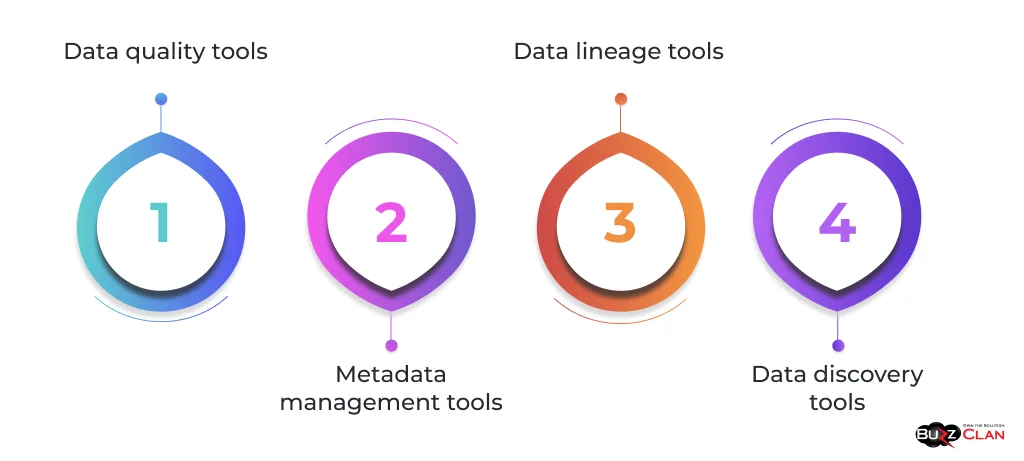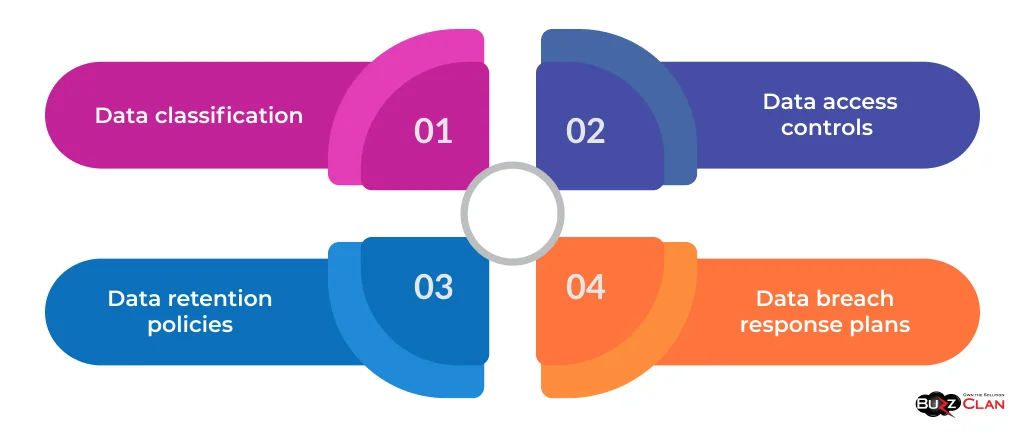Mastering Data Governance: A Comprehensive Overview
Vikram Verma
Apr 24, 2024
Introduction to Data Governance
Data has become a critical asset for organizations across all industries in the digital age. As data volume, variety, and velocity grow, the need for effective data governance has become more pressing than ever. Data governance refers to the overall management of the availability, usability, integrity, and security of the data employed in an enterprise. It is a set of processes, policies, standards, and metrics that ensure the effective use of data to enable an organization to achieve its goals.
The significance of data governance cannot be overstated. It helps organizations ensure that their data is accurate, consistent, and reliable, essential for making informed business decisions. Effective data governance also helps organizations comply with increasingly stringent data privacy regulations, such as the General Data Protection Regulation (GDPR) and the California Consumer Privacy Act (CCPA).
Data governance has evolved significantly over the years. In the past, data governance was often seen as a bureaucratic and time-consuming process that hindered business agility. However, as organizations have realized the strategic value of data, data governance has become a critical enabler of business success. Today, data governance is a collaborative effort that involves stakeholders from across the organization, including IT, business, and legal teams.
Foundations of Data Governance
Data governance is the management of enterprise data's availability, usability, integrity, and security. It involves establishing policies, procedures, and standards for effectively managing data throughout its lifecycle, from creation to deletion.
The key objectives of data governance include:

- Ensuring data quality: Data governance helps ensure that data is accurate, complete, and consistent across the organization.
- Enabling data security: Data governance helps protect sensitive data from unauthorized access, modification, or deletion.
- Facilitating compliance: Data governance helps organizations comply with data privacy regulations and industry standards.
- Improving data accessibility: Data governance helps ensure that data is easily accessible to authorized users when and where they need it.
- Supporting business objectives: Data governance helps align data management practices with business goals and strategies.
Data governance interacts with other organizational processes in several ways. For example, data governance policies and procedures may be integrated with data management practices, such as data modeling, data integration, and data quality management. Data governance may also interact with IT governance, risk management, and compliance processes.
Data Governance Frameworks
A data governance framework is a set of policies, procedures, and standards that define how an organization manages its data. There are several widely recognized data governance frameworks, including:
- DAMA DMBOK: The Data Management Association's Data Management Body of Knowledge (DMBOK) is a comprehensive guide to data management practices, including data governance.
- COBIT: The Control Objectives for Information and Related Technologies (COBIT) is a framework for IT governance and management, which includes data governance as a key component.
- DGI Data Governance Framework: The Data Governance Institute (DGI) has developed a framework that outlines the key components of a successful data governance program.
Steps to create data governance framework
| Steps | Description |
|---|---|
| Define data governance goals and objectives | Identify the key business drivers for data governance and define measurable goals and objectives. |
| Identify data stakeholders | Identify the key stakeholders who will be involved in the data governance program, including data owners, data stewards, and data users. |
| Develop data governance policies and procedures | Develop policies and procedures that define how data will be managed throughout its lifecycle, including data quality, data security, and data privacy. |
| Establish data governance roles and responsibilities | Define the roles and responsibilities of data stakeholders, including data owners, data stewards, and data users. |
| Implement data governance tools and technologies | Identify and implement tools and technologies supporting the data governance program, such as data quality tools, metadata management tools, and data lineage tools. |
| Monitor and measure data governance effectiveness | Establish metrics and key performance indicators (KPIs) to monitor and measure the effectiveness of the data governance program. |
Data Governance vs. Data Management
Data governance and data management are related but distinct concepts. Data governance is the overall management of the availability, usability, integrity, and security of the data used in an enterprise. In contrast, data management refers to the practices and processes used to manage data throughout its lifecycle.
Data governance sets the policies, procedures, and standards for data management, while data management implements those policies and procedures. For example, data governance may define the policies for data quality, while data management may implement processes for data cleansing and data validation.
Data governance and data management intersect in several ways. For example, data governance policies may dictate how data is stored and accessed, while data management practices may ensure that data is stored securely and accessed only by authorized users. Similarly, data governance may define the policies for data retention, while data management may implement data archiving and deletion processes.
Implementing Data Governance
Implementing a data governance program involves several core components, including:
| Component | Description |
|---|---|
| Data governance council | A data governance council is a cross-functional group of stakeholders overseeing the data governance program. |
| Data governance policies and procedures | Data governance policies and procedures define how data will be managed throughout its lifecycle, including data quality, data security, and data privacy. |
| Data governance roles and responsibilities | Data governance roles and responsibilities define the roles and responsibilities of data stakeholders, including data owners, data stewards, and data users. |
| Data governance tools and technologies | Data governance tools and technologies support the data governance program, including data quality tools, metadata management tools, and data lineage tools. |
Implementing data governance can be challenging, but there are several strategies for overcoming common challenges, including:
- Securing executive sponsorship: Securing executive sponsorship is critical for ensuring the data governance program has the resources and support it needs to succeed.
- Communicating the benefits of data governance: The benefits of data governance, such as improved data quality and reduced risk, can help build support for the program.
- Starting small and scaling up: Starting with a small, focused data governance initiative and scaling up over time can help build momentum and demonstrate the program's value.
- Establishing clear roles and responsibilities: Establishing clear roles and responsibilities for data stakeholders can help ensure that everyone understands their role in the data governance program.
Tools and Technologies
Several tools and technologies can support a data governance program, including:

- Data quality tools: Data quality tools help ensure that data is accurate, complete, and consistent across the organization.
- Metadata management tools: Metadata management tools help manage information about data, such as its definition, source, and lineage.
- Data lineage tools: Data lineage tools help track data movement throughout the organization, from its source to its destination.
- Data discovery tools: They help users find and access the data they need to make informed business decisions.
Technology plays a critical role in enabling better data governance and compliance. For example, data quality tools can help ensure data is accurate and consistent, while data lineage tools can help track data movement throughout the organization. Similarly, metadata management tools can help ensure that data is properly defined and classified, essential for compliance with data privacy regulations.
Data Governance in Different Sectors
Data governance practices may vary depending on the industry and sector. For example, healthcare organizations may have more stringent data privacy and security requirements due to regulations like the Health Insurance Portability and Accountability Act (HIPAA). Similarly, government agencies may have specific data governance requirements related to national security and classified information.
- Healthcare: Healthcare organizations may have specific data governance policies and procedures related to patient privacy and the security of electronic health records (EHRs).
- Finance: Financial institutions may have specific data governance requirements related to fraud detection, anti-money laundering (AML), and know-your-customer (KYC) regulations.
- Retail: Retail organizations may have specific data governance policies related to customer data privacy and the security of payment card information.
Case studies can provide valuable insights into how organizations implement data governance programs successfully. For example, a healthcare organization may have implemented a data governance program to ensure compliance with HIPAA regulations. In contrast, a financial institution may have implemented a data governance program to improve fraud detection and prevent money laundering.
Data Governance Best Practices
To ensure the success of a data governance program, organizations should follow these best practices:
- Secure executive sponsorship: Securing executive sponsorship is critical for ensuring the data governance program has the resources and support it needs to succeed.
- Establish clear roles and responsibilities: Establishing clear roles and responsibilities for data stakeholders can help ensure that everyone understands their role in the data governance program.
- Develop policies and procedures: Developing clear policies and procedures for data management can help ensure that data is managed consistently and effectively throughout the organization.
- Implement tools and technologies: These tools and technologies, such as data quality and metadata management tools, can help support the data governance program.
- Monitor and measure effectiveness: Monitoring and measuring the effectiveness of the data governance program can help identify areas for improvement and demonstrate its value.
To measure the effectiveness of a data governance program, organizations can use several metrics, including:

- Data quality metrics: Data quality metrics, such as accuracy, completeness, and consistency, can help measure the effectiveness of data quality initiatives.
- Data security metrics: Data security metrics, such as the number of data breaches and the time to detect and respond to security incidents, can help measure the effectiveness of data security initiatives.
- Compliance metrics: Compliance metrics, such as the number of regulatory violations and the cost of non-compliance, can help measure the effectiveness of compliance initiatives.
Master Data Governance
Master data governance is a subset of data governance that focuses on managing the critical data assets shared across the organization, such as customer, product, and supplier data. It ensures that master data is accurate, consistent, and secure throughout its lifecycle.
The relationship between master data management and governance is critical. Master data management focuses on the processes and technologies used to manage master data. In contrast, master data governance focuses on the policies, procedures, and standards that ensure the effective management of master data.
Effective master data governance requires collaboration between business and IT stakeholders to define policies and procedures for managing master data. It also requires the use of tools and technologies, such as master data management platforms and data quality tools, to support the management of master data.
The Future of Data Governance
As data continues to grow in volume, variety, and velocity, the future of data governance is likely to be shaped by several trends, including:
- Artificial intelligence and machine learning: AI and ML technologies can help automate data governance processes, such as data quality checks and data classification.
- Cloud computing: As organizations move more of their data to the cloud, adopting cloud computing will likely accelerate the need for data governance.
- Data privacy regulations: The increasing complexity of data privacy regulations, such as GDPR and CCPA, will likely drive the need for more robust data governance practices.
- Data ethics: The ethical use of data is becoming increasingly important, and data governance will play a critical role in ensuring that data is used ethically and responsibly.
To prepare for future data governance challenges, organizations should:
- Develop a data governance strategy: A strategy aligned with business goals and objectives can help ensure the data governance program is effective and sustainable.
- Invest in tools and technologies: Investing in tools and technologies, such as AI and ML technologies, can help automate data governance processes and improve the effectiveness of the data governance program.
- Foster a culture of data governance: Fostering a culture of data governance, where everyone in the organization understands the importance of data governance and their role in it, can help ensure the success of the data governance program.
Developing a Data Governance Strategy
Developing a data governance strategy that is aligned with business goals and objectives is critical for the success of a data governance program. The strategy should define the program's goals and objectives, the policies and procedures for managing data, and the roles and responsibilities of data stakeholders.
Here are some steps for developing a data governance strategy:
| Strategies | Challenges |
|---|---|
| Define the goals and objectives of the data governance program | The program's goals and objectives should be aligned with business goals and objectives, such as improving data quality, reducing risk, and enabling data-driven decision-making. |
| Identify data stakeholders | Identifying the key data stakeholders, such as data owners, stewards, and users, is critical for ensuring the data governance program is effective and sustainable. |
| Develop policies and procedures | Developing clear policies and procedures for managing data, such as data quality, security, and privacy policies, can help ensure that data is managed consistently and effectively throughout the organization. |
| Establish roles and responsibilities | Establishing clear roles and responsibilities for data stakeholders can help ensure that everyone understands their role in the data governance program. |
| Implement tools and technologies | These tools and technologies, such as data quality and metadata management tools, can help support the data governance program. |
| Monitor and measure effectiveness | Monitoring and measuring the effectiveness of the data governance program can help identify areas for improvement and demonstrate its value. |
Examples of data governance strategies in large organizations include:
- IBM: IBM's data governance strategy enables data-driven decision-making, improves data quality, and reduces risk. The strategy includes policies and procedures for managing data throughout its lifecycle and tools and technologies supporting data governance.
- Walmart: Walmart's data governance strategy enables data-driven decision-making and improves the customer experience. The strategy includes policies and procedures for managing data and tools and technologies for supporting data governance, such as a data quality platform and a metadata management tool.
Regulatory Compliance and Data Governance
Data governance is critical in ensuring organizations comply with data privacy regulations like GDPR and CCPA. These regulations require organizations to protect the privacy and security of personal data and to provide individuals with certain rights, such as the right to access their data and the right to be forgotten.
To comply with data privacy regulations, organizations must have robust data governance practices in place, including:

- Data classification: Classifying data based on sensitivity and criticality can help protect and secure personal data.
- Data access controls: Implementing data access controls, such as role-based access controls and data masking, can help ensure that personal data is only accessible to authorized users.
- Data retention policies: Developing data retention policies that specify how long personal data should be retained and when it should be deleted can help ensure compliance with data privacy regulations.
- Data breach response plans: Developing data breach response plans that specify how the organization will respond to a data breach, including notifying individuals and regulators, can help ensure compliance with data privacy regulations.
Other regulations that impact data governance include:
- 1. Sarbanes-Oxley Act (SOX): SOX requires publicly traded companies to maintain accurate financial records and adequate internal controls over financial reporting.
- 2. Health Insurance Portability and Accountability Act (HIPAA): HIPAA requires healthcare organizations to protect the privacy and security of patient data.
- 3. Payment Card Industry Data Security Standard (PCI DSS): PCI DSS requires organizations that process credit card payments to maintain cardholder data security.
Data Governance Certifications and Training
Data governance certifications and training can help individuals and organizations develop the skills and knowledge needed to implement effective data governance programs. Some popular data governance certifications include:

- Certified Data Management Professional (CDMP): DAMA International offers the CDMP certification, which is vendor-neutral and demonstrates expertise in data management, including data governance.
- DGPO Certified Data Governance Professional: The DGPO certification, offered by the Data Governance Professionals Organization, is a vendor-neutral certification demonstrating expertise in data governance.
- IBM Certified Data Governance Specialist: The IBM Certified Data Governance Specialist certification demonstrates expertise in IBM's data governance solutions.
Training and professional development are also critical for ensuring that data governance professionals have the skills and knowledge needed to implement effective data governance programs.
Some options for data governance training and professional development include:
- DAMA International: DAMA International offers a variety of training and professional development opportunities, including webinars, conferences, and workshops.
- Data Governance Professionals Organization (DGPO): The DGPO offers a variety of training and professional development opportunities, including webinars, conferences, and workshops.
- Vendor-specific training: Many data governance vendors, such as IBM and Informatica, offer training and certification programs for their products and solutions.
Data Governance Policies and Standards
Developing effective data governance policies and standards is critical for ensuring data is managed consistently and effectively throughout the organization. Data governance policies and standards should be aligned with business goals and objectives and developed with key data stakeholders.
Some examples of data governance policies and standards include:
- Data quality policy: A data quality policy defines the standards for data quality, including accuracy, completeness, and consistency.
- Data security policy: A data security policy defines the standards for data security, including access controls, encryption, and data loss prevention.
- Data privacy policy: A data privacy policy defines the standards for data privacy, including data classification, data retention, and data breach response.
- Metadata management policy: A metadata management policy defines the standards for managing metadata, including metadata standards, metadata ownership, and metadata quality.
International standards for data governance include:
- ISO/IEC 38505-1:2017: This standard guides data governance in organizations, including principles, policies, and procedures.
- ISO/IEC 27001:2013: This standard specifies the requirements for an information security management system, including data governance and data protection.
- COBIT 2019: This framework guides the governance and management of enterprise IT, including data governance.
Conclusion
Throughout this blog post, we have explored the key aspects of data governance, including its foundations, frameworks, implementation, tools and technologies, best practices, and certifications and training. We have also discussed the importance of master data governance, regulatory compliance, and the development of effective data governance strategies.
As we look to the future, it is clear that data governance will continue to evolve and adapt to new challenges and opportunities. The increasing volume, variety, and velocity of data, coupled with the growing complexity of data privacy regulations and the need for data-driven decision-making, will require organizations to develop more sophisticated and agile data governance practices.
One key trend likely to shape the future of data governance is the convergence of data governance with artificial intelligence (AI) and machine learning (ML). AI and ML technologies have the potential to automate and streamline many data governance processes, such as data quality checks, data classification, and data security monitoring. By leveraging these technologies, organizations can improve the efficiency and effectiveness of their data governance programs while freeing up human resources to focus on more strategic tasks.
Another trend likely to impact future data governance is the increasing importance of data ethics. As organizations collect and use more personal data, there is a growing need to ensure that this data is used ethically and responsibly. Data governance will play a critical role in ensuring that organizations have policies, procedures, and standards to ensure data is used ethically and complies with relevant regulations and standards.
In conclusion, data governance is critical to effective data management in the digital age. By developing a comprehensive data governance strategy aligned with business goals and objectives and leveraging the latest tools and technologies, organizations can ensure that their data is accurate, consistent, secure, and compliant with relevant regulations and standards. As we look to the future, it is clear that data governance will continue to evolve and adapt to new challenges and opportunities and will play an increasingly important role in enabling organizations to derive value from their data assets.
FAQs

Get In Touch
